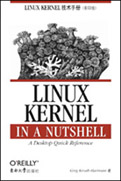
Linux Kernel in a Nutshell(影印版)
出版时间:2007年07月
页数:176
本书由Linux 内核的顶尖开发和维护人员所写,向您提供了全面的内核配置和编译方法,而内核配置和编译正是Linux管理员和开发人员的关键任务。由于没有任何一个Linux的发行版可以仅用一个内核就满足所有人的需要,而面对各种计算机多多少少的特殊需求,对内核进行重新配置和重新编译就在所难免。《Linux Kernel技术手册》解释了如何让Linux按您所需要的表现和性能进行工作。
本书集中讲解2.6版,这个版本的内核已经将Linux带入了企业IT环境的心脏。相比此前的版本,这个版本的内核中的几乎每个子系统都做了显著的改进,尤其是在内存管理和块设备方面,改动尤为明显。2.6版的内核具有优异的灵活性,能够运行在从手持设备到大型主机等一系列广泛的设备上,并且可以支持服务器和个人桌面计算机两种应用模式。但是,有时这个内核也需要用户的干预,这也就是这本颇具深度的参考手册的写作目的所在。一册在手,您可以了解:
● 从下载内核源代码开始,编译并安装内核所需的全部步骤
● 确保所用工具与您的内核源代码版本相匹配的指南
● 诸如运行时内核选项控制这类相关主题的参考资料和讨论
● 各种“药方”列出您所需要的各项明细,以便您完成各项内容广泛的任务
Linux的内核几乎包含了所有能够连接到计算机上的外部设备的驱动程序。本书的第8章是一个独具特色的章节,它说明了如何明确决定您的计算机选用哪个驱动程序。
无论您是试图用Linux听音乐,或者为一台笔记本电脑提供无线网络支持和电源管理,还是在一个大型的服务器上添加企业级的功能,如逻辑卷(logical volume)管理,2.6版的内核都能够胜任分配给它的任何任务。为了发挥它的所有潜能,您需要知道Linux提供的各种选择和配置选项。《Linux Kernel技术手册》为此提供了深入的精辟见解。
Greg Kroah-Hartman是一位Linux内核开发人员并负责维护好几个内核子系统。他所在的团队负责稳定内核版本的发布。
本书集中讲解2.6版,这个版本的内核已经将Linux带入了企业IT环境的心脏。相比此前的版本,这个版本的内核中的几乎每个子系统都做了显著的改进,尤其是在内存管理和块设备方面,改动尤为明显。2.6版的内核具有优异的灵活性,能够运行在从手持设备到大型主机等一系列广泛的设备上,并且可以支持服务器和个人桌面计算机两种应用模式。但是,有时这个内核也需要用户的干预,这也就是这本颇具深度的参考手册的写作目的所在。一册在手,您可以了解:
● 从下载内核源代码开始,编译并安装内核所需的全部步骤
● 确保所用工具与您的内核源代码版本相匹配的指南
● 诸如运行时内核选项控制这类相关主题的参考资料和讨论
● 各种“药方”列出您所需要的各项明细,以便您完成各项内容广泛的任务
Linux的内核几乎包含了所有能够连接到计算机上的外部设备的驱动程序。本书的第8章是一个独具特色的章节,它说明了如何明确决定您的计算机选用哪个驱动程序。
无论您是试图用Linux听音乐,或者为一台笔记本电脑提供无线网络支持和电源管理,还是在一个大型的服务器上添加企业级的功能,如逻辑卷(logical volume)管理,2.6版的内核都能够胜任分配给它的任何任务。为了发挥它的所有潜能,您需要知道Linux提供的各种选择和配置选项。《Linux Kernel技术手册》为此提供了深入的精辟见解。
Greg Kroah-Hartman是一位Linux内核开发人员并负责维护好几个内核子系统。他所在的团队负责稳定内核版本的发布。
- Preface
- Part I. Building the Kernel
- 1. Introduction
- Using This Book
- 2. Requirements for Building and Using the Kernel . .
- Tools to Build the Kernel
- Tools to Use the Kernel
- 3. Retrieving the Kernel Source
- What Tree to Use
- Where to Find the Kernel Source
- What to Do with the Source
- 4. Configuring and Building
- Creating a Configuration
- Modifying the Configuration
- Building the Kernel
- Advanced Building Options
- 5. Installing and Booting from a Kernel
- Using a Distribution's Installation Scripts
- Installing by Hand
- Modifying the Bootloader for the New Kernel
- 6. Upgrading a Kernel
- Download the New Source
- Applying the Patch
- Reconfigure the Kernel
- Can't This Be Automated?
- Part II. Major Customizations
- 7. Customizing a Kernel
- Using a Distribution Kernel
- Determining the Correct Module from Scratch
- 8. Kernel Configuration Recipes
- Disks
- Devices
- CPU
- Networking
- Filesystems
- Security
- Kernel Debugging
- Part III. Kernel Reference
- 9. Kernel Boot Command-Line Parameter Reference
- Module-Specific Options
- Console Options
- Interrupt Options
- Memory Options
- Suspend Options
- CPU Options
- Scheduler Options
- Ramdisk Options
- Root Disk Options
- Init Options
- kexec Options
- RCU Options
- ACPI Options
- SCSI Options
- PCI Options
- Plug and Play BIOS Options
- SELinux Options
- Network Options
- Network File System Options
- Hardware-Specific Options
- Timer-Specific Options
- Miscellaneous Options
- 10. Kernel Build Command-Line Reference
- Informational Targets
- Cleaning Targets
- Configuration Targets
- Build Targets
- Packaging Targets
- Documentation Targets
- Architecture-Specific Targets
- Analysis Targets
- 11. Kernel Configuration Option Reference
- Part IV. Additional Information
- A. Helpful Utilities
- Managing Your Patches with quilt
- git
- ketchup
- B. Bibliography
- Index
书名:Linux Kernel in a Nutshell(影印版)
国内出版社:东南大学出版社
出版时间:2007年07月
页数:176
书号:978-7-5641-0742-0
原版书出版商:O'Reilly Media
The animal on the cover of Linux Kernel in a Nutshell is a cup coral (Balanophyllia
elegans). Most commonly found on or under shaded rocks,cup corals
range from British Columbia to Baja,California. Cup corals are generally orange
in color, with lighter orange tentacles extending out from the stony skeleton base.
Cup corals are armed with tentacles that have clusters of poisoning stingers called
spirocysts, which they use to prey on passing plankton. Once plankton is
captured, the coral will use its tentacles to draw the food into its stomach. Cup
corals also use their tentacles to attach themselves to rocks.
The cover image is from Riverside Natural History. The cover font is Adobe ITC
Garamond. The text font is Linotype Birka; the heading font is Adobe Myriad
Condensed; and the code font is LucasFont's TheSans Mono Condensed.
elegans). Most commonly found on or under shaded rocks,cup corals
range from British Columbia to Baja,California. Cup corals are generally orange
in color, with lighter orange tentacles extending out from the stony skeleton base.
Cup corals are armed with tentacles that have clusters of poisoning stingers called
spirocysts, which they use to prey on passing plankton. Once plankton is
captured, the coral will use its tentacles to draw the food into its stomach. Cup
corals also use their tentacles to attach themselves to rocks.
The cover image is from Riverside Natural History. The cover font is Adobe ITC
Garamond. The text font is Linotype Birka; the heading font is Adobe Myriad
Condensed; and the code font is LucasFont's TheSans Mono Condensed.
购买选项